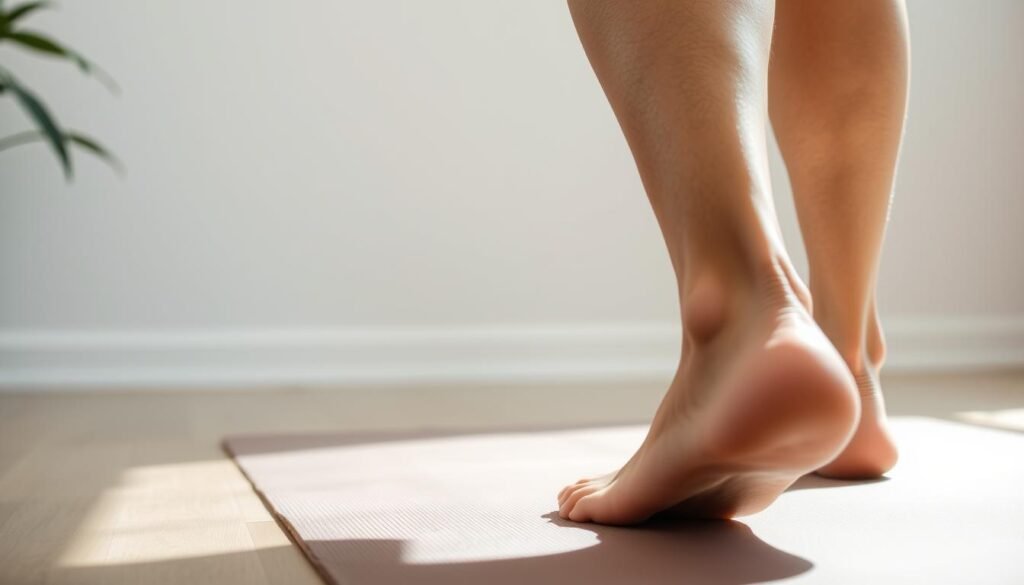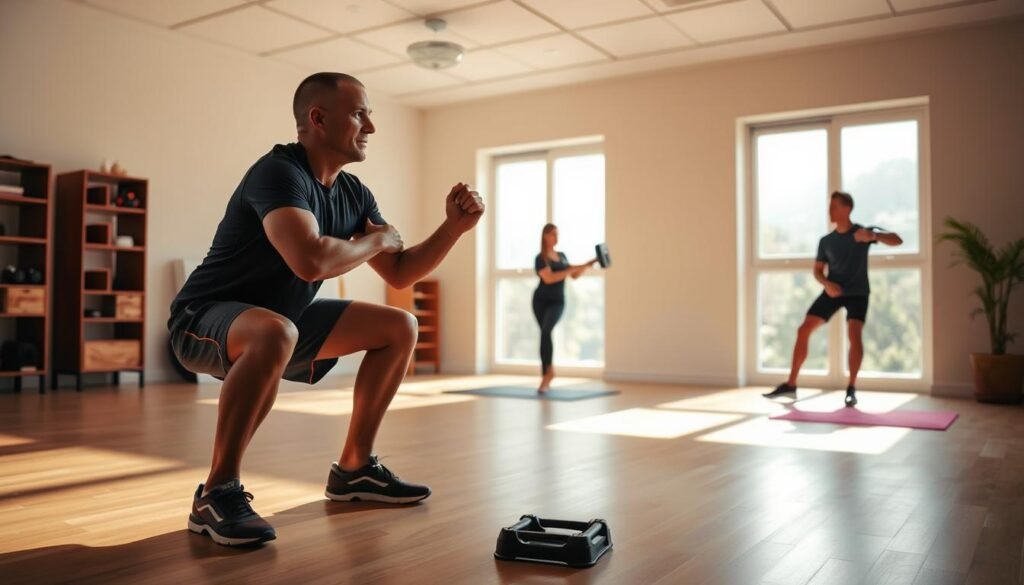
What if the key to overcoming knee pain isn’t rest alone but strategic movement? For athletes and active individuals, persistent discomfort below the kneecap can feel like a roadblock. We’re here to break down how targeted exercises can rebuild strength and restore mobility—without risking further injury.
Managing this condition requires a balance of patience and action. Our approach focuses on safe, evidence-based techniques to strengthen the muscles supporting the patellar tendon. Whether you’re a weekend warrior or a competitive athlete, these methods adapt to your routine.
In this guide, we’ll share step-by-step instructions for movements that prioritize proper form. Resistance bands, bodyweight drills, and simple home equipment play a critical role in rebuilding stability. You’ll also learn how to adjust repetitions, sets, and positioning to match your recovery stage.
Key Takeaways
- Strengthening surrounding leg muscles reduces strain on the tendon.
- Proper form prevents re-injury during recovery workouts.
- Resistance bands offer adjustable intensity for gradual progress.
- Pain management starts with listening to your body’s signals.
- Consistency over time yields long-term improvements in mobility.
Understanding Patellar Tendinitis and Jumper’s Knee
Many athletes face a common yet misunderstood challenge: gradual knee deterioration from overuse. This condition, often called jumper’s knee, develops when repetitive stress weakens the tendon connecting the kneecap to the shinbone. Sports requiring frequent jumps or sudden stops—like basketball and volleyball—are prime contributors.
Definition and Causes
Patellar tendinitis occurs when tiny tears form in the tendon due to excessive strain. Over time, activities like sprinting or acute knee pain after running worsen inflammation. The table below outlines how specific movements affect tendon health:
| Activity | Impact on Tendon | Resulting Symptom |
|---|---|---|
| Basketball jumps | Repeated landing force | Sharp pain below kneecap |
| Volleyball spikes | Sudden directional changes | Swelling around joint |
| Long-distance running | Sustained pressure | Stiffness during movement |
Common Symptoms and Warning Signs
Early indicators include tenderness when pressing the area or difficulty straightening the leg fully. Discomfort often starts mild but escalates if ignored. Swelling and a dull ache after activity signal the need for modified training.
Ignoring these signs risks chronic damage. Athletes who adjust workouts early typically recover faster. Listening to your body’s limits is key to long-term mobility.
The Science Behind Knee Rehabilitation
The human knee isn’t just a hinge—it’s a dynamic system where bones, muscles, and connective tissues collaborate. Every jump, pivot, or step relies on this intricate balance. When one component weakens, others compensate, creating vulnerability.
Role of Muscles and Tendons
Healthy muscles act as shock absorbers, reducing strain on the tendon during impact. The quadriceps and hamstrings work like pulleys, stabilizing the joint through its full range of motion. Weakness in these areas shifts pressure to less resilient tissues.
Here’s how the lower body supports recovery:
- Strong quads improve force distribution during landings
- Flexible hamstrings maintain proper joint alignment
- Balanced calf muscles enhance shock absorption
Tendons adapt slower than muscles, requiring gradual loading. Collagen fibers realign over time, building resilience against repetitive stress. Targeted movements encourage this remodeling process without overwhelming delicate structures.
Understanding this interplay helps design routines that address both immediate strength gaps and long-term health. For example, controlled squats strengthen multiple muscle groups while teaching the body to move as a coordinated unit.
Effective Patellar Tendinitis Rehab Exercises (Jumper’s Knee) for Recovery
Recovering from joint discomfort requires more than movement—it demands precision. Every angle and alignment matters when rebuilding strength in sensitive areas. We prioritize techniques that protect tissues while gradually restoring function.
Proper Form and Technique
Incorrect posture during workouts can worsen irritation. Keep your hips level and avoid letting the knee drift inward during movements. For example, when bending, ensure your heel stays grounded to distribute weight evenly—a tip that’s critical for those managing front knee pain when bending.
Focus on slow, controlled motions rather than speed. This reduces sudden strain on connective tissues. Imagine drawing energy from your core to stabilize each action.
Step-by-Step Exercise Instructions
Straight-leg raises: Lie flat, tighten your thigh muscle, and lift one leg 12 inches off the ground. Hold for 5 seconds, then lower. Repeat 10 times per side. This isolates the quadriceps without joint compression.
Step-ups: Use a 6-inch platform. Place your entire foot on the step, push through the heel, and avoid locking the joint at the top. Start with 2 sets of 8 repetitions daily. If balance is challenging, hold a wall for support.
Rest 60 seconds between sets to let muscles reset. Adjust heights or durations based on your comfort level—progress should feel challenging but never sharp or burning.
Simple Exercises to Strengthen Your Knee
Rebuilding joint stability starts with foundational movements that prioritize control over intensity. We focus on low-impact drills that activate key muscle groups while protecting delicate tissues. These methods adapt to home environments, requiring minimal equipment for consistent progress.

Straight-Leg Raises and Short-Arc Quads
Begin lying flat with one leg bent and the other extended. Tighten your thigh muscle, then lift the straight leg 8-10 inches off the floor. Hold for 3 seconds before lowering slowly. Aim for 2 sets of 12 repetitions daily.
For short-arc quads, place a foam roller under your knee. Gently straighten the leg by contracting the front thigh muscles, pausing at the top. This isolates the quadriceps without stressing the joint.
Step Ups and Terminal Knee Extensions
Use a sturdy step or low bench. Place your entire foot on the surface, pushing through the heel to lift your body. Keep movements smooth—avoid locking the joint at the peak. Start with 3 sets of 10 per side.
Attach a resistance band to a fixed point behind you. Loop it around the back of your knee, then slowly straighten the leg against tension. This targets the tendon’s end range, improving elasticity.
Consistency with these drills builds endurance in muscles that support daily movements. Adjust repetitions or band resistance as strength improves, always prioritizing pain-free motion. Pair them with balanced nutrition for optimal tissue repair.
Integrating Resistance Bands and Home Equipment
Simple tools can transform basic movements into precision recovery tools. Resistance bands add adjustable tension to workouts, mimicking real-world forces without joint strain. This adaptability makes them ideal for rebuilding leg strength at home.
Using Resistance Bands Effectively
Anchor bands securely to stable objects like door frames or heavy furniture. Loop them below the knee for seated leg extensions, or above the ankle for lateral walks. Always check connections before starting sets to prevent slips.
Try these modifications to common drills:
- Wrap a band around thighs during squats to activate outer hip muscles
- Attach one end to a fixed point behind you for resisted step-ups
- Use light resistance during straight-leg raises to improve control
Bands allow gradual progression—simply grip higher or shorten the length. “Controlled resistance teaches muscles to stabilize before handling heavier loads,” notes a physical therapy study. Pair these with bodyweight exercises for balanced development.
Home equipment like chairs or staircases becomes versatile training aids. A sturdy table edge supports balance during single-leg stands, while steps enable controlled elevation changes. Always prioritize smooth motion over speed to protect healing tissues.
Low Impact Workouts for Overall Knee Health
Movement variety matters more than intensity when rebuilding joint resilience. Low-impact activities let you stay active while reducing strain on sensitive areas. Swimming, cycling, and elliptical sessions maintain cardiovascular fitness without pounding forces—ideal for those managing discomfort.
| Activity | Key Benefit | Weekly Frequency |
|---|---|---|
| Swimming | Zero-impact resistance | 3-4 sessions |
| Cycling | Controlled range of motion | 4-5 sessions |
| Elliptical | Fluid joint movement | 3-5 sessions |
Incorporating Flexibility and Balance
Dynamic stretches prepare muscles for activity while improving elasticity. Try leg swings or yoga poses like downward dog to enhance mobility. Balance drills—such as single-leg stands on foam pads—train stabilizer muscles critical for sports like basketball.
For volleyball players, lateral lunges with a focus on hip alignment build durability. Pair these with water-based drills to simulate jumps without hard landings. Cyclists benefit from hamstring-focused stretches to maintain pedal efficiency.
Moderate-intensity workouts prevent overloading healing tissues. The Alberta Health Services guidelines recommend alternating activity days with rest to allow tissue repair. Listen to your body—discomfort lasting hours post-workout signals the need to adjust intensity.
Aim for a weekly mix: 3 strength sessions, 2 flexibility routines, and 1 sport-specific drill. This balance promotes long-term health while keeping workouts engaging. Consistency with low-stress movements builds lasting joint confidence.
Guidelines for Safe Exercise and Recovery
Building resilience in sensitive areas requires more than just movement—it demands mindful preparation and recovery. Proper routines before and after workouts protect tissues while maximizing progress. We’ll outline how to structure sessions for safety and effectiveness.
Preparing and Restoring Your Body
Begin every session with 5-10 minutes of light cardio, like brisk walking or cycling. This increases blood flow to the thigh and back muscles without straining the joint. Follow with dynamic stretches, such as leg swings, to improve range of motion.
Rest intervals matter as much as activity time. Between sets:
- Allow 45-60 seconds for bodyweight drills
- Take 90 seconds after resistance band exercises
- Pause 2 minutes between strength-focused repetitions
Cool-downs should last 8-10 minutes. Gentle foam rolling or static stretches help reduce stiffness. If discomfort persists beyond 30 minutes post-workout, reduce intensity next time.
Gradual recovery hinges on alternating activity days with rest. Studies show tissues repair faster when given 48 hours between intense sessions. Pair this with sleep optimization—7-9 hours nightly—to accelerate healing.
Modify movements if pain exceeds a 3/10 scale. Elevate legs after workouts to minimize swelling, and use ice packs for 15-minute intervals if needed. “Consistent pacing prevents setbacks,” advises a sports medicine specialist. Track progress weekly to ensure steady improvement without overexertion.
Adapting Exercises for Daily Activities and Sports
Rehab movements become powerful tools when they mimic real-world demands. We design routines that bridge gym work and sport-specific actions, helping athletes transition safely back to play. This approach builds functional strength while reinforcing proper movement patterns.

Tailoring Drills to Sport Demands
Volleyball players benefit from modified lunges that simulate blocking motions. Instead of standard forward steps, shift sideways while keeping hips aligned. This trains lateral stability—critical for quick net reactions without stressing the joint.
Basketball athletes can adjust squat depth to match jumping mechanics. Partial-range squats with a resistance band above the knees improve takeoff power. Pair these with step-up variations that emphasize controlled landings.
Key technique tips for all sports:
- Maintain neutral spine alignment during rotational moves
- Engage core muscles before initiating explosive motions
- Land softly with bent legs to absorb impact forces
These tweaks reduce strain during high-intensity actions. A study of collegiate athletes showed 34% fewer reinjuries when drills mirrored game scenarios. Consistency with adapted routines also enhances muscle memory, making safe movements automatic over time.
Adjust training volume based on competition schedules. During peak seasons, prioritize maintenance sets over heavy loading. Off-seasons allow deeper focus on imbalance correction and foundational strength building.
Conclusion
Rebuilding knee resilience demands a smart blend of movement and mindfulness. Our approach combines targeted strength drills with recovery strategies that protect delicate tissues. Proper form, gradual resistance adjustments, and low-impact activities create a sustainable path forward.
Using home equipment like bands or steps allows customized progression while minimizing strain. Studies confirm that structured routines improve joint health and reduce re-injury risks—especially for sports like basketball or volleyball. Remember: consistency matters more than speed.
Balance activity with rest to let muscles rebuild. If discomfort lingers beyond workouts, consult a specialist to refine your plan. Every body heals differently, but patience paired with our guidelines fosters lasting mobility.
Prioritize long-term health over quick fixes. With disciplined effort, you’ll regain confidence in your leg’s capabilities—step by controlled step.
